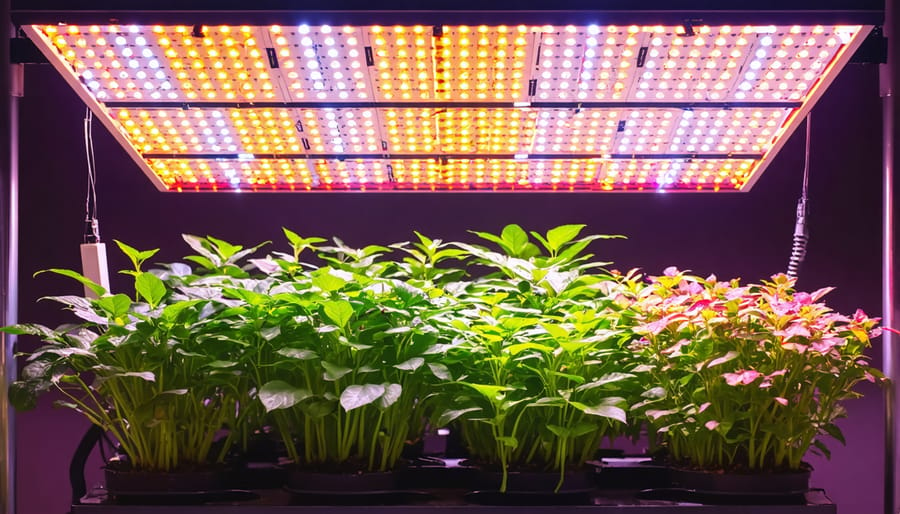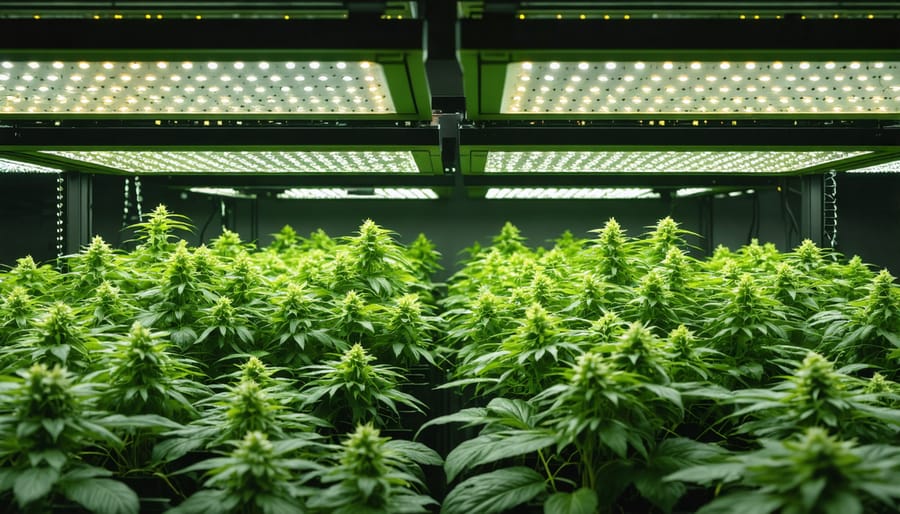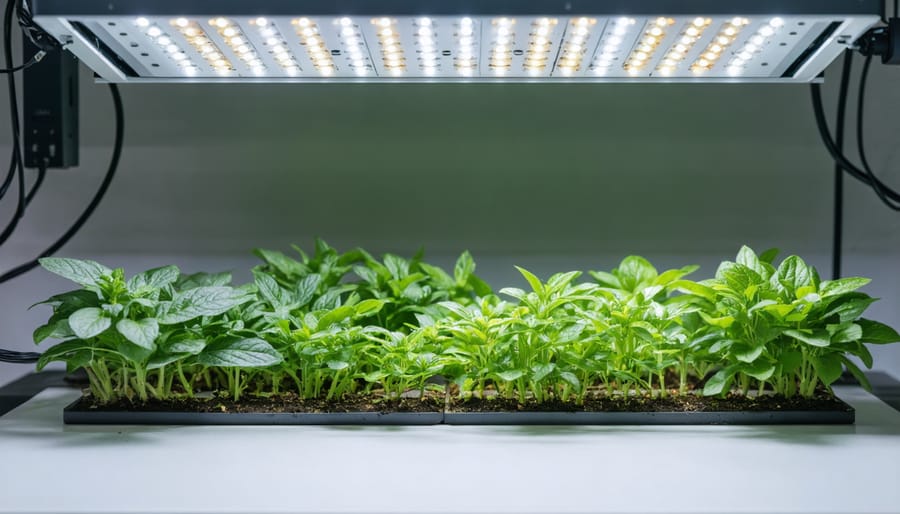Transform your indoor growing space with LED grow lights that deliver up to 60% more energy efficiency than traditional HPS systems while maintaining optimal plant growth. Modern energy efficient lighting solutions have revolutionised indoor cultivation, combining sophisticated photosynthetic spectrums with minimal power consumption.
Today’s top-performing LED grow lights merge cutting-edge semiconductor technology with precision optics, delivering targeted light wavelengths that match plants’ exact photosynthetic needs. By eliminating wasted energy on unnecessary light spectrums, these systems dramatically reduce electricity costs while maximising crop yields.
Australian growers are increasingly switching to smart LED systems with programmable light cycles, automated dimming, and built-in cooling systems that further reduce energy usage. These features, combined with an average lifespan of 50,000+ hours, make modern LED grow lights the most cost-effective and environmentally responsible choice for both home gardeners and commercial operations.
The latest quantum board LEDs and micro-LED arrays represent the pinnacle of growing efficiency, producing more usable light per watt than any previous technology. When paired with reflective materials and strategic placement, these systems can illuminate your growing space effectively while consuming minimal power.
Understanding Energy Efficiency in Grow Lights
PAR, PPF, and PPFD: The Real Measures of Efficiency
When selecting energy-efficient grow lights, understanding the key metrics of light measurement is crucial for Aussie growers. PAR (Photosynthetically Active Radiation) represents the specific light wavelengths that plants use for photosynthesis, ranging from 400 to 700 nanometres. Think of PAR as the quality of light your plants can actually use, rather than just the brightness our eyes perceive.
PPF (Photosynthetic Photon Flux) measures the total amount of PAR produced by your grow light each second. However, what really matters for your indoor garden is PPFD (Photosynthetic Photon Flux Density) – the amount of usable light that actually reaches your plants. PPFD is measured in μmol/m²/s (micromoles per square metre per second), and different plants need different PPFD levels to thrive.
For most leafy greens in Australian indoor gardens, a PPFD of 200-400 μmol/m²/s works well, while flowering plants might need 400-600 μmol/m²/s. By focusing on these metrics rather than watts or lumens, you’ll ensure your grow lights deliver the right light to your plants while maximising energy efficiency.
Watts vs. Light Output: Breaking Down the Numbers
When comparing grow lights, don’t be fooled by wattage alone – it’s the light output that truly matters for your plants. While traditional HPS lights might draw 600 watts to produce usable light, modern LED grow lights can achieve similar results with just 300-400 watts, offering significant energy savings for Aussie growers.
The key is to look at PAR (Photosynthetically Active Radiation) values and efficacy rates, measured in μmol/J (micromoles per joule). Top-tier LED grow lights now achieve efficacy rates of 2.5-3.0 μmol/J, compared to 1.7 μmol/J for older technologies. This means more light reaching your plants for every watt consumed.
For example, a 400W LED grow light with 2.8 μmol/J efficacy can produce the same growing power as a 600W HPS system, potentially saving you up to $200 annually on your energy bill. When shopping for grow lights, look for fixtures that list their PPF (Photosynthetic Photon Flux) and efficacy ratings – these numbers tell the real story of efficiency, not just the power draw.
Remember, local electricity rates in Australia make energy efficiency even more crucial for sustainable indoor growing.
Top Energy-Efficient Grow Light Technologies
Modern LED Solutions
LED technology has revolutionised indoor growing across Australia, offering growers an energy-efficient solution that doesn’t compromise on plant health. Modern LED grow lights have come a long way from their early predecessors, now featuring sophisticated spectrum control and remarkable energy efficiency ratings that can slash power bills by up to 60% compared to traditional lighting systems.
Today’s LED solutions incorporate multiple wavelengths precisely tuned to match plants’ photosynthetic needs. Many Australian growers are particularly fond of full-spectrum LED panels that combine deep red, blue, and supplementary wavelengths to support everything from seedlings to flowering plants. These lights run significantly cooler than older technologies, reducing the need for additional cooling and further cutting energy costs.
What makes modern LEDs truly stand out is their smart features. Many units now come with built-in timing systems, adjustable intensity settings, and even smartphone connectivity for remote management. This level of control helps growers fine-tune their lighting schedule to match natural growing patterns while minimising energy waste.
Local success stories include Brisbane-based vertical farms achieving exceptional results with latest-generation LED arrays, producing fresh herbs and microgreens year-round while maintaining surprisingly low power bills. The initial investment in quality LED systems typically pays for itself within 12-24 months through reduced energy consumption and improved crop yields.
The current generation of LED grow lights also boasts impressive longevity, often lasting 50,000 hours or more before requiring replacement, making them a sustainable choice for both home growers and commercial operations.

Quantum Board LEDs
Quantum board LEDs have revolutionised indoor growing in Australia, offering remarkable energy efficiency without compromising on plant growth. These innovative lighting systems consist of numerous small LED diodes mounted on a flat panel, creating an even spread of light that closely mimics natural sunlight.
What sets quantum boards apart is their superior efficiency rating, typically achieving 2.5 to 3.0 μmol/joule. In practical terms, this means you’re getting more usable light for your plants while drawing less power from the grid. Many Aussie growers report energy savings of up to 40% compared to traditional HID systems, making a real difference to both their electricity bills and carbon footprint.
The secret lies in the latest Samsung or Osram LED chips, strategically arranged to maximise photon output while minimising heat production. This design not only reduces energy waste but also means you’ll spend less on cooling your grow space – a significant advantage in our warm climate.
Most quantum boards available in Australia now come with customisable spectrum options, allowing you to adjust the light recipe for different growing stages. While the initial investment might be higher than some alternatives, the long-term savings on energy costs typically offset this within 12-18 months of regular use. Plus, with an operational lifespan of 50,000+ hours, these lights offer sustainable growing solutions for years to come.

Smart Grow Light Systems
Smart automation is revolutionising how Aussie growers manage their indoor gardens, offering significant energy savings while maintaining optimal growing conditions. These intelligent systems combine sensors, timers, and adaptive controls to create the perfect environment for your plants without wasting precious energy.
Modern smart grow light systems use sophisticated sensors to monitor natural light levels, automatically adjusting artificial lighting intensity as needed. For instance, on cloudy days in Melbourne, the system might increase output, while on bright Sydney afternoons, it’ll dial back the power. This responsive approach can reduce energy consumption by up to 40% compared to traditional timer-based setups.
Many Australian growers are now embracing systems that integrate with mobile apps, allowing remote monitoring and adjustment of light schedules. These apps often provide detailed energy usage reports, helping you track and optimise your power consumption over time.
The latest smart systems also feature spectrum-tuning capabilities, delivering exactly what your plants need at different growth stages. During vegetative growth, they might focus on blue light, switching to red spectrum during flowering – all while maintaining peak energy efficiency.
Local community gardens and small commercial operations are increasingly adopting these systems, particularly in urban areas where energy costs are highest. The initial investment typically pays for itself within 12-18 months through reduced power bills and improved crop yields.
Maximising Energy Efficiency in Your Growing Setup
Strategic Light Positioning
Strategic light placement can make or break your indoor growing success while significantly impacting energy consumption. Optimal light positioning starts with understanding your grow space dimensions and plant requirements.
For most leafy greens and herbs, position lights 30-45 centimetres above the canopy. Flowering plants typically need stronger light intensity, so keep fixtures 25-35 centimetres away. Remember that light intensity decreases dramatically with distance – even a few centimetres can make a difference in energy efficiency.
Create overlapping light coverage zones to eliminate dark spots and maintain uniform growth. In typical Aussie grow spaces, aim for about 20% overlap between light fixtures. Use adjustable hanging systems with easy-release mechanisms to modify height as plants grow.
Consider installing reflective materials on walls to maximise light utilisation. White paint works well for budget setups, while mylar sheeting offers superior reflection rates of up to 95%. This simple addition can reduce the number of fixtures needed, cutting energy costs while maintaining optimal growth conditions.

Timing and Scheduling
Getting your grow light timing right is crucial to optimize equipment efficiency and reduce power consumption. For most indoor plants, 12-16 hours of light per day is ideal, with timing adjusted to make the most of off-peak electricity rates in your area.
Consider using automated timers to ensure consistent scheduling and prevent wastage from accidentally leaving lights on. Many Aussie growers have success running their lights from 7 PM to 7 AM, taking advantage of cheaper night rates while helping balance the grid during peak daylight hours.
For seedlings and young plants, start with 14 hours of light and gradually adjust based on growth response. Flowering plants typically need 12 hours of darkness to trigger blooming, so plan accordingly. Remember to account for seasonal changes – you might need longer light periods during winter months to compensate for shorter days.
Most modern LED grow lights come with built-in timing features, making it easier to maintain an energy-efficient schedule. Setting up your system to mimic natural daylight patterns while considering energy costs will help you achieve the best balance between plant health and power consumption.
Australian Energy Rebates and Incentives
Australian growers can access various energy rebate programs to make the switch to efficient grow lights more affordable. The Small-scale Technology Certificates (STCs) scheme offers financial incentives when upgrading to energy-efficient lighting systems, including LED grow lights that meet specific efficiency standards.
In Victoria, the Victorian Energy Upgrades (VEU) program provides substantial discounts on energy-efficient lighting installations. Small businesses can receive up to $2,000 through the Small Business Energy Saver Program when upgrading to LED lighting systems, including horticultural applications.
NSW residents can take advantage of the Energy Savings Scheme (ESS), which offers financial incentives for switching to energy-efficient lighting. The scheme typically covers around 50% of the upgrade costs, making the transition to efficient grow lights significantly more affordable.
Queensland’s Business Energy Savers Program provides free energy audits and implementation support for agricultural businesses, including indoor growing operations. Coupled with the federal government’s instant asset write-off scheme, these initiatives make energy-efficient grow lights a smart investment.
Local councils often run additional sustainability programs, so it’s worth checking with your council for extra support. Many utility providers also offer energy-efficiency rebates and payment plans to help spread the cost of upgrading your growing setup.
Remember to keep documentation of your current lighting system and energy usage to maximise your rebate eligibility and demonstrate energy savings after installation.
Cost Analysis and ROI
Energy Savings Calculator
To calculate your potential energy savings with efficient grow lights, start by noting your current lights’ wattage and daily operating hours. Multiply these numbers by your electricity rate (average 30 cents per kWh in Australia) to establish your baseline costs. Next, compare this with the wattage of energy-efficient LED grow lights you’re considering.
For example, if you’re replacing a 600W HPS light running 12 hours daily with a 300W LED, you’d save approximately 1,314 kWh annually. At current rates, that’s nearly $394 in savings per year! Factor in potential rebates through state energy efficiency programs and renewable energy integration opportunities to maximise your benefits.
Use our simple formula:
(Current Watts – New LED Watts) × Hours per Day × 365 ÷ 1000 = Annual kWh Savings
Annual kWh Savings × Your Electricity Rate = Yearly Dollar Savings
Remember to consider the initial investment against long-term savings, typically achieving ROI within 12-18 months in most Australian growing operations.
Real Australian Case Studies
Sydney-based hydroponic farmer James Mitchell switched to LED grow lights in his 200-square-metre indoor farm, cutting energy costs by 65% while maintaining optimal growth for his leafy greens. “The initial investment paid for itself within 18 months,” says Mitchell, who now helps other urban farmers make the transition.
In Melbourne, the Common Ground Community Garden collective upgraded their indoor seedling station with energy-efficient quantum boards, reducing their power consumption by 40%. Their success inspired five other community gardens across Victoria to follow suit.
Perth urban farmer Sarah Wong experimented with different light spectrums in her microgreens operation, ultimately finding that targeted spectrum LED lights not only saved energy but improved crop quality. “We’re using 30% less power and seeing faster germination rates,” Wong reports. Her setup now serves as a demonstration site for local growers interested in sustainable indoor farming practices.
As we’ve explored, choosing the right energy-efficient grow light is crucial for sustainable indoor growing in Australia. LED technology leads the way, offering substantial energy savings while delivering optimal light spectrums for plant growth. By selecting fixtures with high PPE ratings and understanding your specific growing needs, you can significantly reduce your environmental impact and energy bills.
Remember, efficiency isn’t just about choosing the right equipment – it’s about creating a holistic growing system. Consider incorporating natural light when possible, implementing smart controls, and maintaining proper distance between lights and plants. These practices not only maximise energy efficiency but also contribute to healthier plant growth.
As our community faces increasing energy challenges, making sustainable choices in indoor growing becomes more important than ever. Whether you’re a home gardener or running a commercial operation, your choice of energy-efficient grow lights makes a real difference to both your bottom line and our environment.
Start small if needed, but start today. Every switch to more efficient growing practices helps build a more sustainable future for Australian agriculture. Together, we can grow smarter, cleaner, and more efficiently while maintaining the high-quality results we need.
